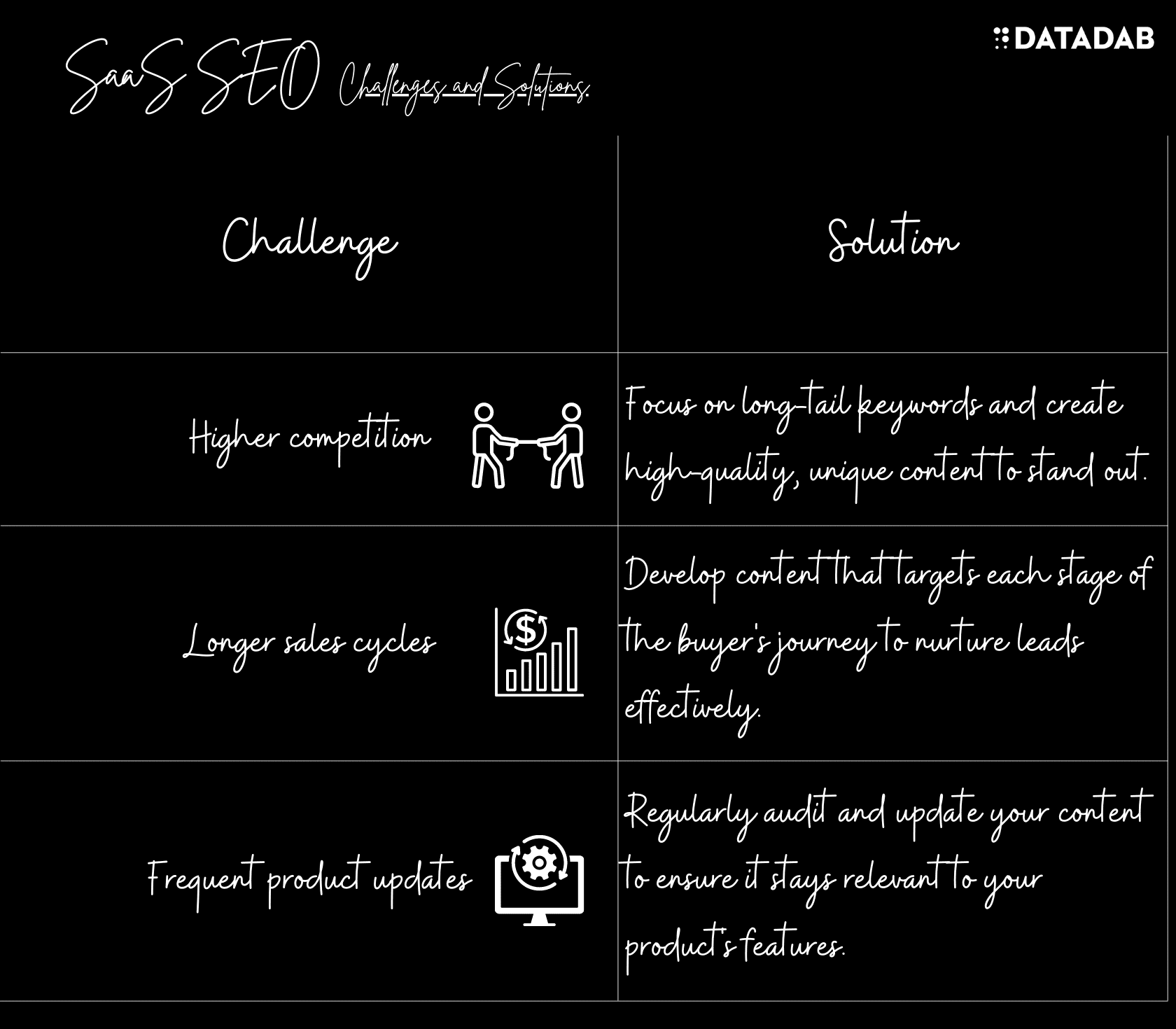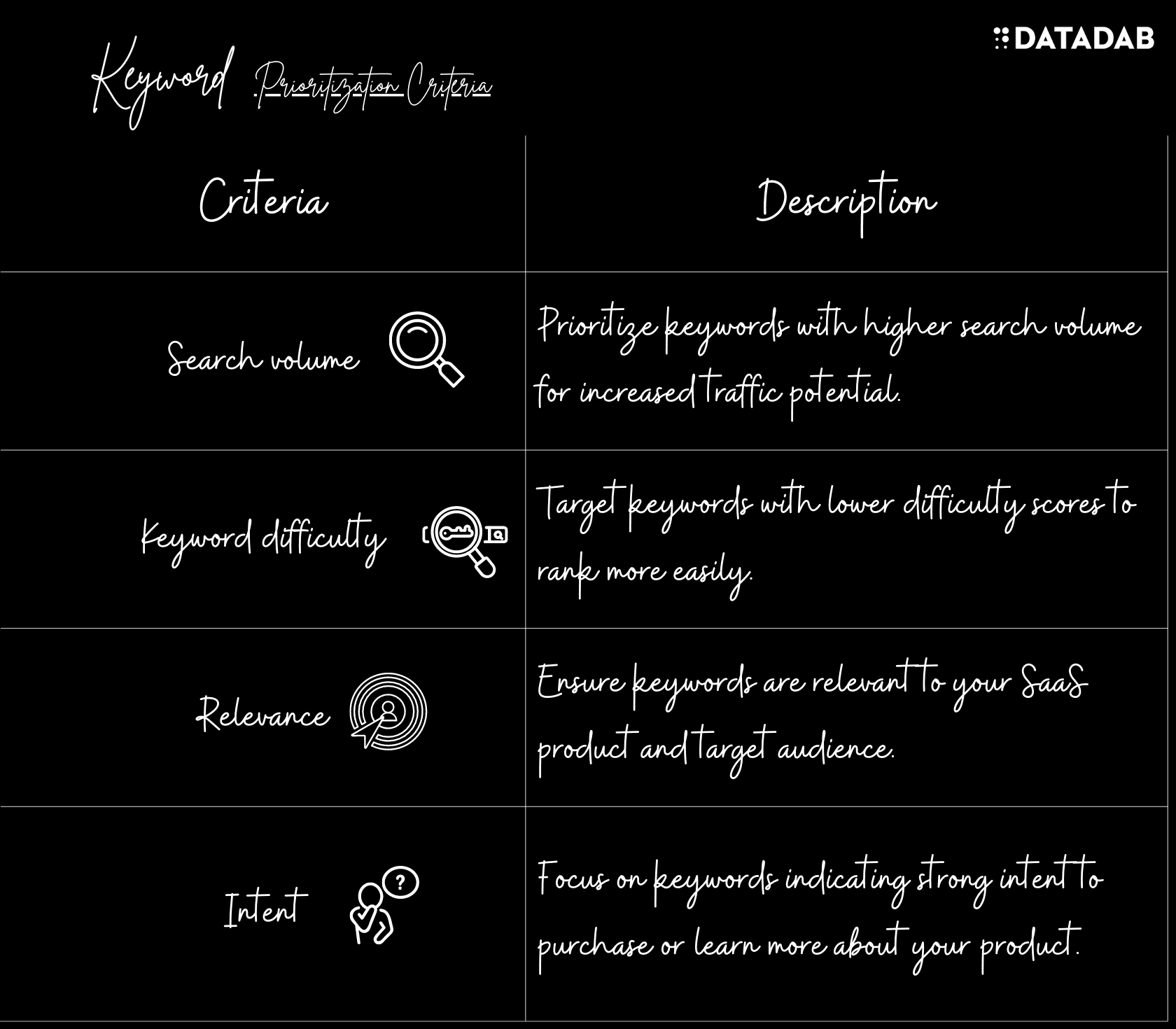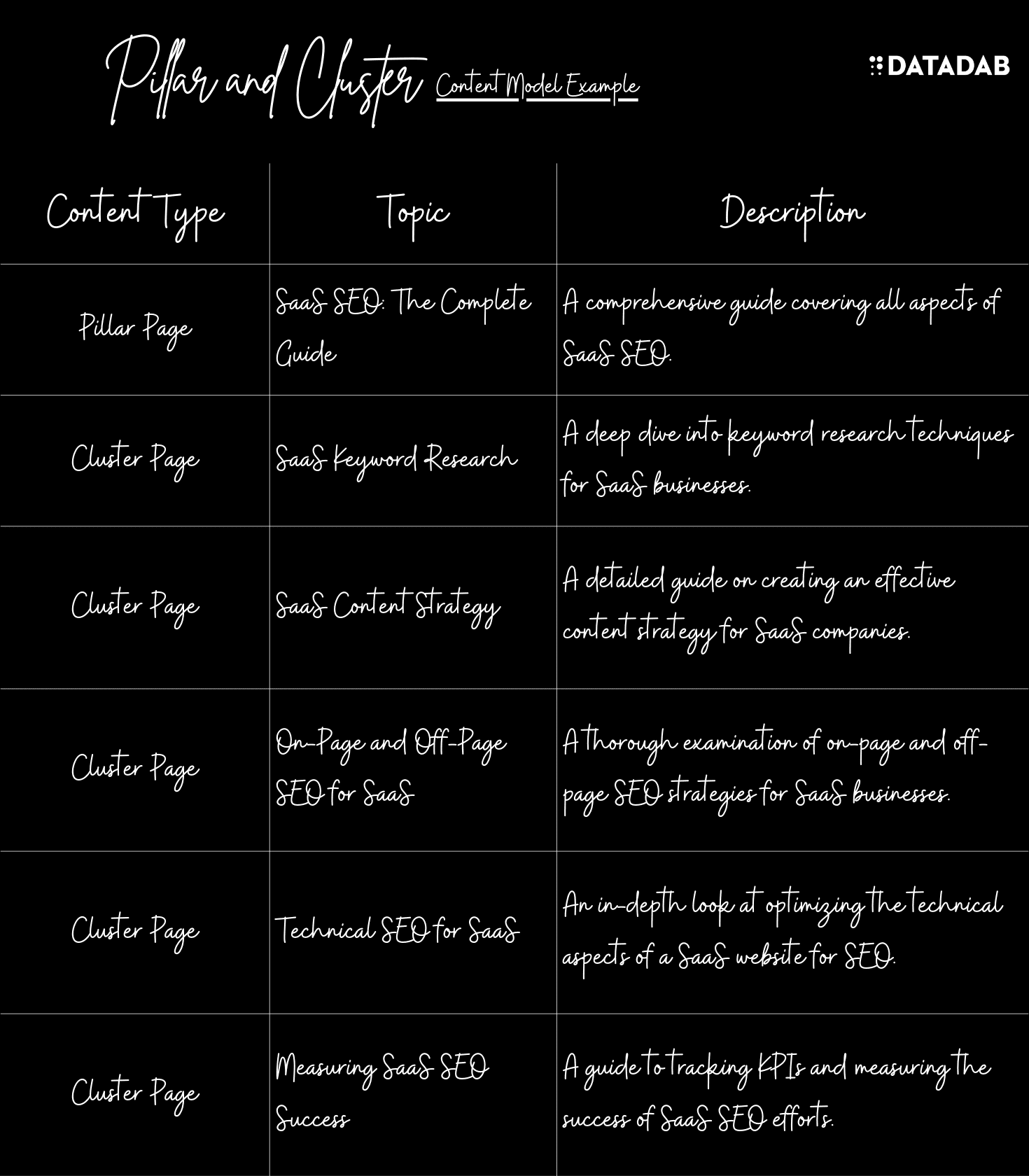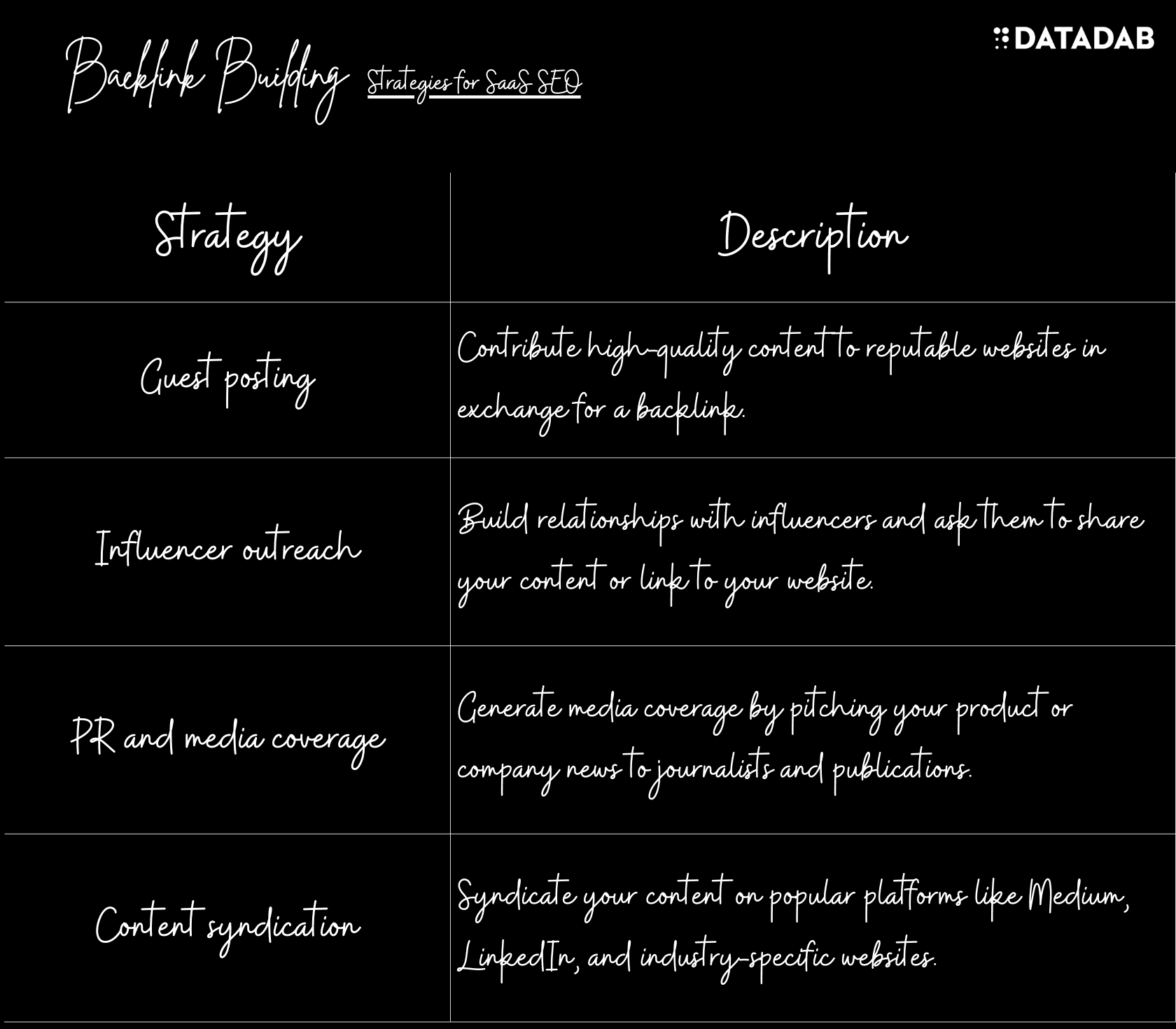"The success of your SaaS SEO strategy lies in the delicate balance between creativity, technical prowess, and data-driven insights."

SEO is like a fine art. And when it comes to SaaS companies, mastering the art of SEO can be particularly challenging. That's because SaaS businesses are unique in their marketing needs, with customers seeking solutions to specific problems.
In this guide, we'll explore the essential strategies for SaaS SEO, focusing on driving organic traffic and generating high-quality leads. By the end of this article, you'll know how to approach SEO in a way that's tailored specifically to your SaaS business.
1. Understanding SaaS SEO
At its core, the goal of SEO is to attract organic traffic to your website by optimizing your content for search engines. This involves targeting relevant keywords, creating high-quality content, and optimizing your website's technical aspects.
For SaaS companies, this means crafting an SEO strategy that caters to your unique audience, services, and competitive landscape.
Unique Challenges of SaaS SEO
SaaS businesses face unique challenges when it comes to SEO:
- Higher competition: SaaS is a crowded market with many companies offering similar products and services, making it harder to stand out in search results.
- Longer sales cycles: SaaS products often involve longer sales cycles, requiring you to focus on nurturing leads throughout the funnel.
- Frequent product updates: SaaS products often evolve rapidly, requiring you to constantly update your content to stay relevant.

2. Keyword Research
Keyword research is the foundation of your SEO strategy. By understanding the keywords your target audience is using, you can create content that addresses their needs and solves their problems.
Targeting Long-Tail Keywords
For SaaS companies, focusing on long-tail keywords is essential. These are longer, more specific phrases that are less competitive and often have higher conversion rates. To find long-tail keywords:
- Use keyword research tools: Tools like Ahrefs, SEMRush, and Ubersuggest can help you find long-tail keywords related to your niche.
- Analyze your competitors: Identify the keywords your competitors are ranking for and use them as inspiration.
- Explore forums and communities: Visit online communities where your target audience hangs out and look for commonly asked questions and discussions.
Prioritizing Keywords
Once you've identified a list of long-tail keywords, prioritize them based on:
- Search volume: Focus on keywords with a higher search volume, as they have the potential to drive more traffic.
- Keyword difficulty: Target keywords with lower difficulty scores, as they will be easier to rank for.
- Relevance: Ensure the keywords are relevant to your SaaS product and target audience.
- Intent: Focus on keywords that indicate a strong intent to purchase or learn more about your product.

3. Content Strategy
A well-planned content strategy is crucial for SaaS SEO. It allows you to create content that resonates with your target audience, addresses their pain points, and showcases your product's value.
Creating a Content Plan
Develop a content plan by following these steps:
- Identify content gaps: Analyze your existing content and identify areas that need improvement or new topics to cover.
- Align content with your buyer's journey: Create content that addresses the different stages of your buyer's journey, from awareness to consideration to decision.
- Mix content formats: Use a variety of content formats, such as blog posts, whitepapers, case studies, webinars, and videos, to keep your audience engaged.
- Optimize for shareability: Make your content easily shareable on social media and other platforms.
Content Pillars and Cluster Model
One effective approach for SaaS content strategy is the content pillar and cluster model. In this model, you create a comprehensive pillar page that covers a core topic in depth, and then create a series of cluster pages that delve into specific subtopics.
This approach allows you to:
- Establish topical authority: By covering a topic comprehensively, you demonstrate your expertise and establish your brand as an authority.
- Improve internal linking: Cluster pages can link back to the pillar page, helping to distribute link equity and improve overall SEO.
- Streamline content creation: Focusing on a core topic allows you to generate multiple pieces of content more efficiently.
4. On-Page SEO
On-page SEO involves optimizing individual web pages to improve their search engine rankings and user experience. Key elements to focus on include:
Title Tags and Meta Descriptions
- Title tags: Write unique, descriptive title tags that include your target keyword and accurately describe the content of the page.
- Meta descriptions: Craft compelling meta descriptions that include your target keyword and entice users to click on your search result.
Headers and Subheaders
- H1 tag: Use your target keyword in your H1 tag, which should be a concise and descriptive headline for your content.
- H2 and H3 tags: Break up your content with H2 and H3 subheadings that include relevant keywords and make your content easily skimmable.
URL Structure
- Short and descriptive: Keep your URLs short, descriptive, and easy to read.
- Keyword inclusion: Include your target keyword in the URL when it makes sense and doesn't feel forced.
Internal and External Linking
- Internal linking: Link to related content on your website to help users navigate and improve your site's SEO.
- External linking: Link to reputable external sources to provide additional value and improve your content's credibility.

5. Off-Page SEO
Off-page SEO refers to actions taken outside of your website that affect your search engine rankings. A primary focus of off-page SEO is building high-quality backlinks.
Backlink Building Strategies
- Guest posting: Contribute high-quality content to reputable websites in your industry in exchange for a backlink.
- Influencer outreach: Build relationships with influencers and ask them to share your content or link to your website.
- PR and media coverage: Generate media coverage by pitching your product or company news to journalists and publications.
- Content syndication: Syndicate your content on popular platforms like Medium, LinkedIn, and industry-specific websites.
6. Technical SEO
Technical SEO involves optimizing your website's infrastructure to improve search engine crawling and indexing. Ensuring your website is technically sound will provide a solid foundation for your SEO efforts.
Site Speed
- Optimize images: Compress and resize images to reduce their file size without compromising quality.
- Minify code: Minify your HTML, CSS, and JavaScript files to reduce file sizes and improve page load times.
- Leverage caching: Use browser and server-side caching to speed up your website's load times for returning visitors.
Mobile Responsiveness
- Responsive design: Ensure your website is designed to adapt seamlessly to different devices and screen sizes.
- Mobile-friendly navigation: Make sure your site's navigation is intuitive and easy to use on mobile devices.
- Optimize for touch: Design your site's elements with touch in mind, making them large enough to tap and avoiding elements like hover menus.
Site Structure
- Use a flat site structure: Aim for a flat site structure with as few clicks as possible between your homepage and your most important content.
- Optimize navigation: Ensure your site's navigation is clear, concise, and easy to use.
- Use breadcrumbs: Implement breadcrumb navigation to help users understand their location within your site and improve internal linking.
Schema Markup
- Implement schema markup: Use schema markup to provide search engines with additional information about your content, helping to improve the way it's displayed in search results.
- Test your markup: Use Google's Structured Data Testing Tool to ensure your schema markup is implemented correctly.
7. Measuring Success
To understand the effectiveness of your SaaS SEO efforts, it's essential to track your progress and measure your success. Key performance indicators (KPIs) to monitor include:
- Organic traffic: Track the number of visitors coming to your website through organic search.
- Keyword rankings: Monitor your website's rankings for your target keywords over time.
- Conversion rate: Measure the percentage of organic traffic that converts into leads or customers.
- Time on site and bounce rate: Analyze user engagement metrics to understand how visitors are interacting with your content.
Use tools like Google Analytics, Google Search Console, and Ahrefs to gather data and monitor your KPIs.
8. Conclusion
Mastering the art of SaaS SEO is an ongoing process that requires constant learning, experimentation, and adaptation. By implementing the strategies outlined in this guide, you'll be well on your way to driving organic traffic and generating high-quality leads for your SaaS business.
Remember to:
- Understand the unique challenges of SaaS SEO.
- Conduct thorough keyword research and target long-tail keywords.
- Develop a comprehensive content strategy that aligns with your buyer's journey.
- Optimize your on-page SEO elements, including title tags, headers, and URLs.
- Focus on off-page SEO, particularly building high-quality backlinks.
- Ensure your website is technically sound by optimizing site speed, mobile responsiveness, and site structure.
- Measure your success using KPIs like organic traffic, keyword rankings, and conversion rates.
By putting in the effort to fine-tune your SaaS SEO strategy, you'll reap the rewards of increased visibility, organic traffic, and ultimately, more leads for your business.
FAQ
How long does it take to see results from SaaS SEO efforts?
It's essential to understand that SEO is a long-term strategy and results may not be immediate. Depending on the competitiveness of your industry and the effort put into your SEO strategy, it can take anywhere from 3 to 6 months or even longer to see significant improvements in your organic traffic and rankings. Keep in mind that consistent effort, regular content updates, and ongoing optimizations will contribute to long-term success.
What are some common SaaS SEO mistakes to avoid?
- Targeting overly competitive keywords: Focusing on highly competitive keywords can make it difficult to rank well, especially for newer or smaller SaaS businesses. Instead, prioritize long-tail keywords with lower competition.
- Producing low-quality content: Low-quality content not only fails to engage your audience but can also harm your SEO efforts. Prioritize creating high-quality, valuable content that addresses your target audience's needs and pain points.
- Ignoring technical SEO: Technical aspects like site speed, mobile responsiveness, and site structure play a significant role in your overall SEO success. Ensure you address these areas to create a strong foundation for your SEO efforts.
- Overlooking link building: Backlinks remain an essential factor in search engine rankings. Develop a link-building strategy that focuses on acquiring high-quality backlinks from reputable websites.
How can I identify the most valuable long-tail keywords for my SaaS business?
Begin by conducting keyword research using tools like Ahrefs, SEMrush, or Google Keyword Planner. Look for long-tail keywords with a reasonable search volume, lower keyword difficulty, high relevance to your business, and strong purchase intent. Additionally, consider brainstorming with your sales and customer support teams, as they may provide insights into the phrases and questions your customers commonly use.
Should I focus on optimizing my website for specific search engines like Google or Bing?
While it's essential to optimize your website for various search engines, it's worth noting that Google dominates the search engine market share. Therefore, focusing your efforts on Google's best practices and guidelines will likely yield the best results. However, don't ignore Bing or other search engines entirely. Ensuring your website is accessible, user-friendly, and follows SEO best practices will generally benefit your rankings across multiple search engines.
What are the best ways to earn high-quality backlinks for my SaaS website?
Some effective strategies for earning high-quality backlinks include:
- Guest posting on reputable websites in your industry
- Collaborating with influencers and industry experts on content projects
- Creating high-quality, shareable content that attracts organic backlinks
- Pitching your product or company news to journalists and media outlets for coverage
How can I improve the readability of my SaaS content?
To improve the readability of your content, consider the following tips:
- Break your content into short paragraphs and use subheadings to make it easily skimmable.
- Use bullet points or numbered lists to present information concisely.
- Write in a conversational tone and avoid using jargon or overly complex language.
- Use a readability tool like Hemingway App to identify areas for improvement.
How can I ensure my SaaS website is mobile-friendly?
To ensure your website is mobile-friendly, follow these best practices:
- Implement responsive design to make your website adapt seamlessly to different screen sizes and devices.
- Optimize your site's navigation and layout for touch interactions, with larger buttons and easily accessible menus.
- Use legible font sizes and ensure text is easily readable on smaller screens.
- Test your website's mobile responsiveness using Google's Mobile-Friendly Test tool.
What role does social media play in SaaS SEO?
While social media itself is not a direct ranking factor for search engines, it can indirectly impact your SEO efforts in several ways:
- Sharing your content on social media can increase its visibility, driving more traffic to your website.
- Greater content exposure can lead to more backlinks, as people are more likely to link to popular and widely-shared content.
- A strong social media presence can help build brand awareness and authority, which may contribute to higher search rankings.For these reasons, it's essential to include social media promotion as part of your overall SaaS SEO strategy.
How can I track the success of my SaaS SEO efforts?
To track the success of your SaaS SEO efforts, use tools like Google Analytics to monitor key performance indicators (KPIs), such as organic traffic, keyword rankings, conversion rate, time on site, and bounce rate. Create custom dashboards to visualize your data, and schedule regular performance reviews to discuss progress and areas for improvement.
What role does content repurposing play in SaaS SEO?
Content repurposing can be a valuable tactic in your SaaS SEO strategy for several reasons:
- It helps you make the most of your existing high-performing content, reaching new audiences and driving additional traffic to your website.
- By presenting your content in different formats (e.g., turning a blog post into a video or infographic), you can cater to different audience preferences and learning styles.
- Repurposing content can save time and resources, as you can leverage existing research and insights to create new content assets.
To effectively repurpose content, identify your best-performing pieces and brainstorm ways to present the information in new, engaging formats.






